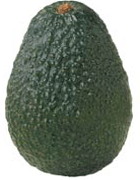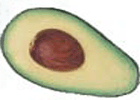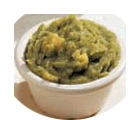|
|
Avocado

|
Avocado,
an excelent fruit associated with lush, good taste and native to the
tropics is not any more just everyday tropical luxury. Avocados' rich,
buttery
texture and mild, nut-like flavor has made them popular in Latin
American cuisine for hundreds of years. While Latinos are generous with
their
use of avocados due to their culinary heritage, North Americans have
lagged
behind in their use. |
Avocados are rich in taste
and nutrition and one of nature's most nutrient-dense foods. They're
cholesterol-free,
sodium-free, low in saturated fat and loaded with dietary fiber,
vitamins
B6, C, E and potassium. Avocados also contain lutein
and phytochemicals
which are natural plant nutrients that help protect against a variety
of
cancers and diseases. Avocado is high in fat,
but fat in avocados is the healthful, monounsaturated variety, shown to
reduce cholesterol levels and helps to decrease the risk of heart
disease
and stroke and one more reason to enjoy healthy avocados, on a daily
basis!
There
are
several varieties of avocados, but the three
most common are the bright green, thin skinned Fuerte, which is the
same
size as a pear; the Haas, which is shaped like a pear and has dark
purplish green
skin and pebbly surface; and the Florida avocado, which is large, and
round
fruit with a medium green skin that is frequently dimpled. They are all
equally delicious, but many cook develop a preference for one type over
the others.
Avocados
ripen only after
they are picked, so most of those found on shelves are as hard as
rocks.
A ripe avocado will yield slightly to gentle pressure.
When shopping,
look
for avocados with an even, unblemished texture, that are uniformly hard
or soft over their entire surface and feel heavy for their size. Avoid
any avocado with hollows or bruises between the flesh and skin.
Hard
avocados
can be ripened by placing them in a brown paper bag. Close the bag and
set it in a cool spot for three to four days. Some varietis often
develop
brown patches as they ripen. This is just an indication that the
avocado
is almost ripe.
Ripe
avocado
will keep in the refrigerator for two to three days. In general, you
should
serve avocados as soon as possible after cutting them, because once
avocado
becomes exposed to the air, it will immediately start to turn brown.
Sprinkling
citrus juice or vinegar over it will retard this process.
We will
show you here how easy it is to take that fruit native to the tropics
and
create some very extravagant and delicious additions to your everyday
menu
with ease and simplicity.
Browse Recipes:
|
|
Did You Know?
|

|
To
slice avocado, start by cutting
avocado lengthwise around the seed, than rotate the halves to separate.
Remove the seed by
gently
sliding the tip of a spoon underneath it and lifting it out.
You could peel the
avocado
by placing the cut side down and removing the skin with your fingers or
a knife or just simply scoop the flesh out with a spoon. |

|
Summer
cold soups could
also benefit from enrichment with avocado pulp, which adds body,
texture
and a smooth silky mouth feel.
|
| Supposedly
the avocado was first eaten in 291 B.C. in Mexico by a Mayan
princess who believed it held mystical and magical powers. The Aztecs
believed it was and dubbed it ahuacatl (meaning testicle), probably
referring
to the fruit's shape and the way it hangs from the tree in pairs. |
|

|
| Bursting
with flavor! |
| Avocado
pulp combined with
lemon or lime juice and salt makes a wonderful avocado butter. It can
be
used as a sandwich spread, canapé base or filling ingredient. |
|
Never freeze a whole or
cut avocado, only avocado puree
may be frozen. Even though there are many recipes that call
for cooking avocados, the peak flavor, beneficial nutrients, and proper
texture can only be found in the raw fruit. |
|